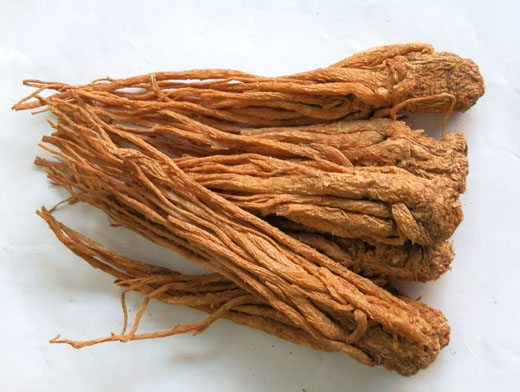It has a few different common names, such as Radix Angelicae Sinensis, Chinese angelica root, dongquai, don quai, angelica herb, tong-kui, tang kuei, and so on. Actually medicinally it refers to dry root of Angelica sinensis (Oliv.) Diels, an herb in the family Apiaceae. The medicinal roots are dug at the end of autumn. Next remove the fibrous roots and dirt, tie them into small bundles after the moisture slightly evaporates, put them on the shelf, and then slowly smoke dry them.
The plant is a perennial herb. Stems are with purple. Basal leaves and leaves on lower stem are ovate, biternate to triternate or pinnatisect, with ovate or ovate-lanceolate lobes, 3 shallowly lobed, and with veins and edges covered with white hairs. Petiole comes with large sheath. Leaves on upper stem are pinnately divided. The inflorescence is compound umbel, with 9 to 13 parachute panel, 2 to 4 small bracts, 12 to 36 pedicels covered with dense pubescence, and white flowers. Cremocarp is oval and with winged lateral ridges. It blooms and fruits from July to September. It grows mainly in cold and rainy mountains. In China, the main cultivation areas are Gansu, Yunnan, and Sichuan provinces.
DONG QUAI BENEFITS
As mentioned previously, dong quai herb is one of the most well-known Chinese herbs. It is so popular that there is an old saying that goes "nine out of ten herbal formulas contain dong quai." As a matter of fact, there are tons of related herbal cuisine recipes and effective remedies in folk. So what is the reason why this herb becomes one of the super stars in the large family of Chinese medicine? Actually the answer is so obvious – its high medicinal value is the main contributor. So, what is dong quai good for and what exact health benefits it can bring with? Here are the details.
POPULAR DONG QUAI RELATED CHINESE HERBAL FORMULAS
From the perspective of Traditional Chinese Medicine (TCM), dong quai is considered sweet, acrid, and warm in properties. And it covers three meridians, including liver, heart, and spleen. Its key functions are to enrich the blood and invigorate the circulation of blood, regulate the menstrual function to ease pain, and loose the bowel to relieve constipation. Main dong quai uses and indications are sallow complexion due to blood deficiency, dizziness and palpitations, Irregular Menstruation, Amenorrhea, Dysmenorrhea, asthenia cold abdominalgia, Constipation due to intestinal dryness, pain in Rheumatoid Arthritis, injuries from falls, fractures, contusions and strains, sore and ulcer, and so on. Recommended dosage is from 6 to 12 grams.

Dong Quai
1) Dang Gui Bu Xue Tang
This formula comes from Lan Shi Mi Cang (Secrets from the Orchid Chamber). This is mainly formulated for asthenia of Qi and blood. Other major herbal ingredients are Huang Qi (Astragals Root) and Ran Shen (Ginseng Root).
2) Dang Gui Cheng Qi Tang
This prescription comes from Su Wen Bing Ji Qi Yi Bao Ming Ji (Collection for Preserving Life of Pathogenesis in Plain Questions). It is basically designed for Yang manic psychosis, manifested as running and cursing everyone no matter close or distant. Other three herbs are Da Huang (Rhubarb), Gan Cao (Licorice Root), and Mang Xiao (Mirabilite).
3) Dang Gui Di Huang Yin
This formula is from Jing Yue Quan Shu (Jingyue’s Complete Works). It is primarily used for deficiency of the kidney, manifested as pains in waist and knee and lower extremity weakness. Other major herbs include Shu Di Huang (Rehmannia), Shan Yao (Chinese Yam), Du Zhong (Eucommia Bark), and so on.
4) Si Wu Tang (Dang Gui Four Combination)
This prescription is from Tai Ping Hui Min He Ji Ju Fang (Formulas of the Peaceful Benevolent Dispensary). It mainly treats sallow complexion due to blood deficiency, heart palpitations, and Insomnia. Other three herbs are Rehmannia, Bai Shao (White Peony Root), and Chuan Xiong (Ligusticum).

![Diseases, Symptoms, tcm, [tcmwindow.com]](/uploadFile/adImg/2015/11/11/f5cbfcc0-4df5-4646-9b9a-f316651a0199.jpg)





